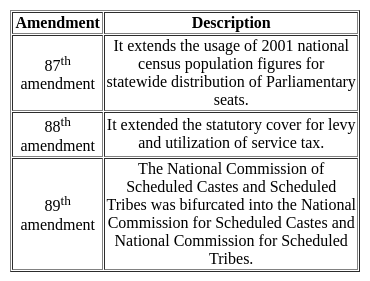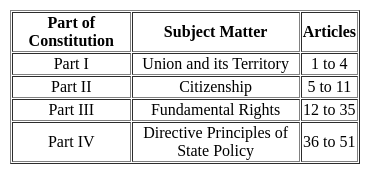Software Development Exam > Software Development Tests > Test: General Awareness (Indian Polity & Political Dimensions) - Software Development MCQ
Test: General Awareness (Indian Polity & Political Dimensions) - Software Development MCQ
Test Description
10 Questions MCQ Test - Test: General Awareness (Indian Polity & Political Dimensions)
Test: General Awareness (Indian Polity & Political Dimensions) for Software Development 2025 is part of Software Development preparation. The Test: General Awareness (Indian Polity & Political Dimensions) questions and answers have been prepared
according to the Software Development exam syllabus.The Test: General Awareness (Indian Polity & Political Dimensions) MCQs are made for Software Development 2025 Exam.
Find important definitions, questions, notes, meanings, examples, exercises, MCQs and online tests for Test: General Awareness (Indian Polity & Political Dimensions) below.
Solutions of Test: General Awareness (Indian Polity & Political Dimensions) questions in English are available as part of our course for Software Development & Test: General Awareness (Indian Polity & Political Dimensions) solutions in
Hindi for Software Development course.
Download more important topics, notes, lectures and mock test series for Software Development Exam by signing up for free. Attempt Test: General Awareness (Indian Polity & Political Dimensions) | 10 questions in 10 minutes | Mock test for Software Development preparation | Free important questions MCQ to study for Software Development Exam | Download free PDF with solutions
Test: General Awareness (Indian Polity & Political Dimensions) - Question 1
Which of the following department is not under the Ministry of Home affairs?
Detailed Solution for Test: General Awareness (Indian Polity & Political Dimensions) - Question 1
Test: General Awareness (Indian Polity & Political Dimensions) - Question 2
Which party government announced the formation of a second backward classes commission in 1978?
Detailed Solution for Test: General Awareness (Indian Polity & Political Dimensions) - Question 2
Test: General Awareness (Indian Polity & Political Dimensions) - Question 3
By whom are political parties in India recognised ?
Detailed Solution for Test: General Awareness (Indian Polity & Political Dimensions) - Question 3
Test: General Awareness (Indian Polity & Political Dimensions) - Question 4
Which of the following is not a department under Ministry of Finance?
Detailed Solution for Test: General Awareness (Indian Polity & Political Dimensions) - Question 4
Test: General Awareness (Indian Polity & Political Dimensions) - Question 5
EVM or Electronic Voting Machine was used for the first time in which state?
Detailed Solution for Test: General Awareness (Indian Polity & Political Dimensions) - Question 5
Test: General Awareness (Indian Polity & Political Dimensions) - Question 6
The procedure of Impeachment of the President of India is __________.
Detailed Solution for Test: General Awareness (Indian Polity & Political Dimensions) - Question 6
Test: General Awareness (Indian Polity & Political Dimensions) - Question 7
Which of the following constitutional amendments provided for the Right to Education?
Detailed Solution for Test: General Awareness (Indian Polity & Political Dimensions) - Question 7
Test: General Awareness (Indian Polity & Political Dimensions) - Question 8
Article 32 belongs to which part of the Indian Constitution?
Detailed Solution for Test: General Awareness (Indian Polity & Political Dimensions) - Question 8
Test: General Awareness (Indian Polity & Political Dimensions) - Question 9
In which Schedule of the Constitution of India is the list of States and Union Territories given?
Detailed Solution for Test: General Awareness (Indian Polity & Political Dimensions) - Question 9
Test: General Awareness (Indian Polity & Political Dimensions) - Question 10
Article 19 of the Indian Constitution includes which of the following right?
Detailed Solution for Test: General Awareness (Indian Polity & Political Dimensions) - Question 10
Information about Test: General Awareness (Indian Polity & Political Dimensions) Page
In this test you can find the Exam questions for Test: General Awareness (Indian Polity & Political Dimensions) solved & explained in the simplest way possible.
Besides giving Questions and answers for Test: General Awareness (Indian Polity & Political Dimensions), EduRev gives you an ample number of Online tests for practice
Download as PDF




















